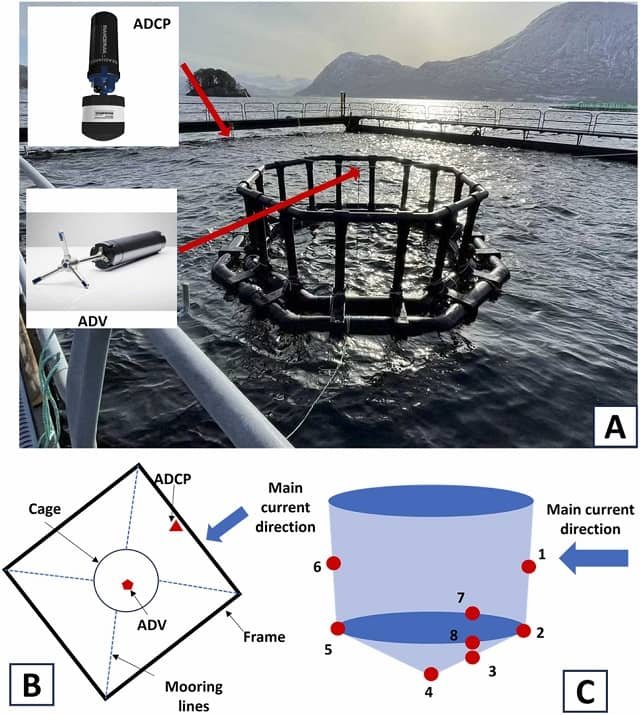
Marine cages are the backbone of oceanic aquaculture. However, these cages are flexible and prone to deformation due to environmental forces such as currents. This deformation can negatively impact fish welfare, farm operations, and even the environment.
Fish farmers must ensure the safety and well-being of their populations. The net cages, where the fish are raised, must withstand the currents they encounter. But predicting how much these cages will deform under different current intensities can be complicated.
A new study by researchers from the Norwegian University of Science and Technology, published in Aquacultural Engineering, sheds light on how to accurately predict net cage deformations, benefiting both fish health and aquaculture structure integrity.
The Challenge: Cage Deformation
Strong currents can cause net cages to bulge and deform. This can negatively impact fish welfare in several ways. Accurate predictions of cage deformation are crucial for two reasons:
- Fish welfare: Excessive deformation can create a cramped environment for the fish, affecting their health and growth.
- Cage safety: Severe deformation can compromise the structural integrity of the cage, potentially leading to equipment failure and fish escape.
How to Predict Cage Deformation?
Accurately predicting how much a net cage will deform is crucial for optimal aquaculture practices. Researchers have used two main approaches:
- Field observations: This involves directly measuring cage movement in real-world environments. However, underwater environments are challenging, with limited visibility and equipment constraints.
- Modeling: Scientists create computer models to simulate cage behavior under various conditions. While valuable, these models have not been extensively compared with real-world data.
Traditionally, researchers relied on acoustic positioning systems to track cage movement. However, these systems have limitations in long-term accuracy. A newer method uses pressure tags, which are more cost-effective and perform well in hostile marine environments. While pressure tags measure depth, additional calculations are needed to determine overall cage deformation.
Researchers studied how net cages interact with surrounding currents at an operational aquaculture farm. The approach involved:
- High-resolution pressure tags: These tracked how much the cage was lifted due to the current.
- Acoustic Doppler Current Profiler (ADCP): This instrument measured incoming currents impacting the cage.
- Acoustic Doppler Velocimeter (ADV): This device measured water flow velocities inside the cage.
- Numerical cage model: A computer model of the cage, built using specialized software (Orcaflex), allowed simulations at different flow speeds.
This combined approach enabled researchers to compare real-world cage deformation with model predictions.
Stay Always Informed
Join our communities to instantly receive the most important news, reports, and analysis from the aquaculture industry.
Findings: Flow Matters, but Not Inside the Cage
The study revealed a strong correlation between incoming current speed and cage lift. In simple terms, faster currents caused the cage to lift more. However, the flow speed measured inside the cage showed a weaker link to upstream flow and cage deformation. This suggests that the complex interactions within the net itself significantly affect the flow experienced by the fish.
Modeling for Better Predictions
Researchers then developed numerical models of the cage using lattice elements. They incorporated flow reduction factors (r) derived from previous studies and in-cage measurements. These factors account for the damping effect the net has on the current passing through it. Interestingly, the model with a flow reduction factor of r = 0.8 provided the most accurate predictions of cage deformation, with depth measurement deviations typically less than 15%.
Conclusion
“The comparison between estimated cage shapes and simulation results shows that models with flow reduction factors of 0.8 can predict cage shapes that fit well with the measurements,” the researchers concluded.
This study provides valuable insights for aquaculture professionals dedicated to designing fish farming cages. The findings demonstrate the effectiveness of high-precision pressure tags in estimating current-induced cage deformation, especially when significant deformations are observed.
Moreover, the success of the numerical model with a specific flow reduction factor highlights the importance of considering the complex interaction between currents and net structures. By incorporating these findings, fish farm operators can develop more accurate predictions of cage behavior under current loads. Ultimately, this leads to better management practices, ensuring the safety and well-being of farmed fish.
Contact
Lars Christian Gansel
Department of Biological Sciences, Norwegian University of Science and Technology
Ålesund, 6025, Norway
Email: lars.gansel@ntnu.no
Reference (open access)
Gao, S., Wang, C., Tuene, S. A., Li, G., Zhang, H., & Gansel, L. C. (2024). In situ measurements and simulations of a net cage in currents. Aquacultural Engineering, 102429. https://doi.org/10.1016/j.aquaeng.2024.102429
Editor at the digital magazine AquaHoy. He holds a degree in Aquaculture Biology from the National University of Santa (UNS) and a Master’s degree in Science and Innovation Management from the Polytechnic University of Valencia, with postgraduate diplomas in Business Innovation and Innovation Management. He possesses extensive experience in the aquaculture and fisheries sector, having led the Fisheries Innovation Unit of the National Program for Innovation in Fisheries and Aquaculture (PNIPA). He has served as a senior consultant in technology watch, an innovation project formulator and advisor, and a lecturer at UNS. He is a member of the Peruvian College of Biologists and was recognized by the World Aquaculture Society (WAS) in 2016 for his contribution to aquaculture.




